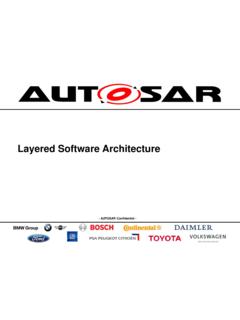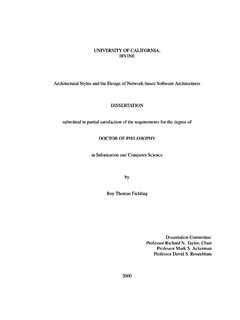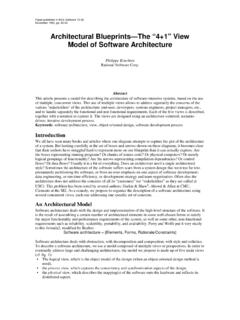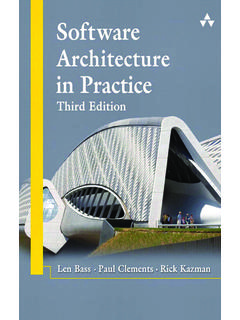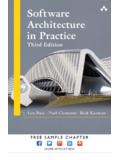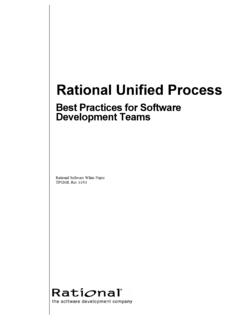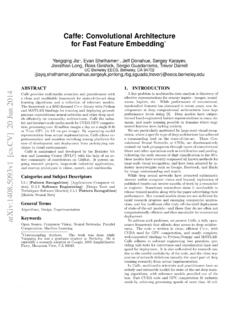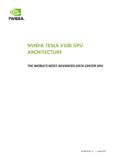Transcription of ISO/IEC/IEEE 42010:2011(E), Systems and software ...
1 Reference numberISO/IEC/IEEE 42010:2011(E) ISO/IEC 2011 IEEE 2011 INTERNATIONAL STANDARD ISO/IEC/IEEE42010 First edition2011-12-01 Systems and software engineering Architecture description Ing nierie des syst mes et des logiciels Description de l'architecture Authorized licensed use limited to: BIBLIOTECA D'AREA SCIENTIFICO TECNOLOGICA ROMA 3. Downloaded on August 30,2012 at 10:44:31 UTC from IEEE Xplore. Restrictions apply. ISO/IEC/IEEE 42010:2011(E) COPYRIGHT PROTECTED DOCUMENT ISO/IEC 2011 IEEE 2011 All rights reserved. Unless otherwise specified, no part of this publication may be reproduced or utilized in any form or by any means, electronic or mechanical, including photocopying and microfilm, without permission in writing from either ISO or IEEE at the respective address below.
2 ISO copyright office Institute of Electrical and Electronics Engineers, Inc. Case postale 56 CH-1211 Geneva 20 3 Park Avenue, New York NY 10016-5997, USA Tel. + 41 22 749 01 11 E-mail Fax + 41 22 749 09 47 Web E-mail Web Published in Switzerland ii ISO/IEC 2011 All rights reserved IEEE 2011 All rights reserved Authorized licensed use limited to: BIBLIOTECA D'AREA SCIENTIFICO TECNOLOGICA ROMA 3. Downloaded on August 30,2012 at 10:44:31 UTC from IEEE Xplore. Restrictions apply. ISO/IEC/IEEE 42010:2011(E) ISO/IEC 2011 All rights reserved IEEE 2011 All rights reserved iii Contents Page Foreword.
3 Iv Introduction .. v 1 Scope .. 1 2 Conformance .. 1 3 Terms and definitions .. 1 4 Conceptual foundations .. 3 Introduction .. 3 Conceptual model of architecture description .. 3 Architecting in the life cycle .. 8 Uses of architecture descriptions .. 8 Architecture frameworks and architecture description languages .. 9 5 Architecture descriptions .. 11 Introduction .. 11 Architecture description identification and overview .. 12 Identification of stakeholders and concerns .. 12 Architecture viewpoints .. 13 Architecture views .. 13 Architecture models.
4 13 Architecture relations .. 14 Architecture rationale .. 15 6 Architecture frameworks and architecture description languages .. 16 Architecture frameworks .. 16 Adherence of an architecture description to an architecture framework .. 17 Architecture description languages .. 17 7 Architecture viewpoints .. 17 Annex A (informative) Notes on terms and concepts .. 19 Annex B (informative) Guide to architecture viewpoints .. 27 Annex C (informative) Relationship to other standards .. 31 Bibliography .. 35 Authorized licensed use limited to: BIBLIOTECA D'AREA SCIENTIFICO TECNOLOGICA ROMA 3.
5 Downloaded on August 30,2012 at 10:44:31 UTC from IEEE Xplore. Restrictions apply. ISO/IEC/IEEE 42010:2011(E) iv ISO/IEC 2011 All rights reserved IEEE 2011 All rights reserved Foreword ISO (the International Organization for Standardization) and IEC (the International Electrotechnical Commission) form the specialized system for worldwide standardization. National bodies that are members of ISO or IEC participate in the development of International Standards through technical committees established by the respective organization to deal with particular fields of technical activity.
6 ISO and IEC technical committees collaborate in fields of mutual interest. Other international organizations, governmental and non-governmental, in liaison with ISO and IEC, also take part in the work. In the field of information technology, ISO and IEC have established a joint technical committee, ISO/IEC JTC 1. IEEE Standards documents are developed within the IEEE Societies and the Standards Coordinating Committees of the IEEE Standards Association (IEEE-SA) Standards Board. The IEEE develops its standards through a consensus development process, approved by the American National Standards Institute, which brings together volunteers representing varied viewpoints and interests to achieve the final product.
7 Volunteers are not necessarily members of the Institute and serve without compensation. While the IEEE administers the process and establishes rules to promote fairness in the consensus development process, the IEEE does not independently evaluate, test, or verify the accuracy of any of the information contained in its standards. International Standards are drafted in accordance with the rules given in the ISO/IEC Directives, Part 2. The main task of ISO/IEC JTC 1 is to prepare International Standards. Draft International Standards adopted by the joint technical committee are circulated to national bodies for voting.
8 Publication as an International Standard requires approval by at least 75 % of the national bodies casting a vote. Attention is called to the possibility that implementation of this standard may require the use of subject matter covered by patent rights. By publication of this standard, no position is taken with respect to the existence or validity of any patent rights in connection therewith. ISO/IEEE is not responsible for identifying essential patents or patent claims for which a license may be required, for conducting inquiries into the legal validity or scope of patents or patent claims or determining whether any licensing terms or conditions provided in connection with submission of a Letter of Assurance or a Patent Statement and Licensing Declaration Form, if any, or in any licensing agreements are reasonable or non-discriminatory.
9 Users of this standard are expressly advised that determination of the validity of any patent rights, and the risk of infringement of such rights, is entirely their own responsibility. Further information may be obtained from ISO or the IEEE Standards Association. ISO/IEC/IEEE 42010 was prepared by Joint Technical Committee ISO/IEC JTC 1, Information technology, Subcommittee SC 7, software and Systems engineering, in cooperation with the software and Systems Engineering Standards Committee of the Computer Society of the IEEE, under the Partner Standards Development Organization cooperation agreement between ISO and IEEE.
10 This first edition of ISO/IEC/IEEE 42010 cancels and replaces ISO/IEC 42010:2007, which has been technically revised. Authorized licensed use limited to: BIBLIOTECA D'AREA SCIENTIFICO TECNOLOGICA ROMA 3. Downloaded on August 30,2012 at 10:44:31 UTC from IEEE Xplore. Restrictions apply. ISO/IEC/IEEE 42010:2011(E) ISO/IEC 2011 All rights reserved IEEE 2011 All rights reserved v Introduction The complexity of man-made Systems has grown to an unprecedented level. This has led to new opportunities, but also to increased challenges for the organizations that create and utilize Systems .
